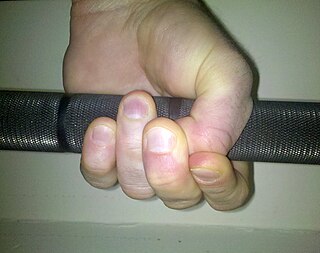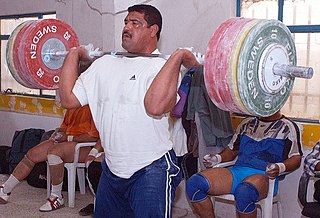
Powerlifting is a strength sport that consists of three attempts at maximal weight on three lifts: squat, bench press, and deadlift. As in the sport of Olympic weightlifting, it involves the athlete attempting a maximal weight single lift of a barbell loaded with weight plates. Powerlifting evolved from a sport known as "odd lifts", which followed the same three-attempt format but used a wider variety of events, akin to strongman competition. Eventually odd lifts became standardized to the current three.

The bench press is an upper-body strength-training exercise that consists of pressing a weight upwards from a supine position. The exercise works the pectoralis major as well as the supporting chest, arm, and shoulder muscles such as the anterior deltoids, serratus anterior, coracobrachialis, scapulae fixers, trapezii, and the triceps. A barbell is generally used to hold the weight, but a pair of dumbbells can also be used.

In strength training and fitness, the squat is a compound, full-body exercise that trains primarily the muscles of the thighs, hips and buttocks, quadriceps femoris muscle, hamstrings, as well as strengthening the bones, ligaments and insertion of the tendons throughout the lower body. Squats are considered a vital exercise for increasing the strength and size of the legs as well as developing core strength. Squats are typically used to tone back, thigh, and hip stability. Isometrically, the lower back, the upper back, the abdominals, the trunk muscles, the costal muscles, and the shoulders and arms are all essential to the exercise and thus are trained when squatting with the proper form.

The deadlift is a weight training exercise in which a loaded barbell or bar is lifted off the ground to the level of the hips, then lowered to the ground. It is one of the three powerlifting exercises, along with the squat and bench press.
The snatch is the first of two lifts contested in the sport of weightlifting followed by the clean and jerk. The objective of the snatch is to lift the barbell from the ground to overhead in one continuous motion. There are four main styles of snatch used: squat snatch, split snatch, power snatch, and muscle snatch. The squat snatch and split snatch are the most common styles used in competition while power snatch and muscle snatch are mostly used for training purposes.

The kettlebell is a cast iron or cast steel ball with a handle attached to the top. It is used to perform many types of exercises, including ballistic exercises that combine cardiovascular, strength and flexibility training. They are also the primary equipment used in the weight lifting sport of kettlebell lifting.
The good-morning is a weight-lifting exercise. It is known as a good morning because of the movement in the erector spinae which resembles the rise out of bed to stretch. The erector spinae muscles of the lower back work isometrically to keep the spine in an extended position while the hamstrings and gluteus maximus work isotonically to perform hip extension. Other muscles are involved in stabilizing weight on the back and maintaining balance.
The clean and press is a variation of the overhead press weight training exercise and was part of the sport of weightlifting in the Olympics until 1972, when it was removed due to difficulties in judging proper technique. The clean and press technique consists of the two main movements for which it is named.
A bent-over row is a weight training exercise that targets a variety of back muscles. Which ones are targeted varies on form. The bent over row is often used for both bodybuilding and powerlifting. It is a good exercise for increasing strength and size.
Gary Deal was a weightlifter for the United States.

In Olympic weightlifting, the hook grip is a method of holding a barbell by gripping the thumb between the barbell and the remaining fingers. It can be used in multiple weightlifting events, including the snatch and the clean and jerk. It can also be used in powerlifting, in the deadlift, for example. When used in the deadlift, the hook grip has a number of advantages. Traditionally, lifters tend to use a "mixed" grip when working with heavy loads on the deadlift, that is, one hand being supine and the other prone. This mixed grip creates an imbalance of the shoulders, with one shoulder being externally rotated and the other internally rotated. This difference in rotation between the shoulders can create imbalances in the muscles of the back over time.
The press, overhead press or shoulder press is a weight training exercise with many variations, typically performed while standing, in which a weight is pressed straight upwards from racking position until the arms are locked out overhead, while the legs, lower back and abs maintain balance. The exercise helps build muscular shoulders with bigger arms, and is one of the most difficult compound upper-body exercises.

A Cable fly or Cable flye is a strength training exercise in which the hand and arm move through an arc while the elbow is kept at a constant angle. Flies are used to work the muscles of the upper body. Because these exercises use the arms as levers at their longest possible length, the amount of weight that can be moved is significantly less than equivalent press exercises for the same muscles . Due to this leverage, fly exercises of all types have a large potential to damage the shoulder joint and its associated ligaments and the tendons of the muscles connecting to it. They should be done with caution and their effects first tested while using very light weights; which are gradually incremented after more strength is gained.
Calf raises are a method of exercising the gastrocnemius, tibialis posterior and soleus muscles of the lower leg. The movement performed is plantar flexion, a.k.a. ankle extension.

A weight plate is a flat, heavy object, usually made of cast iron, that is used in combination with barbells or dumbbells to produce a bar with a desired total weight for the purpose of physical exercise.













